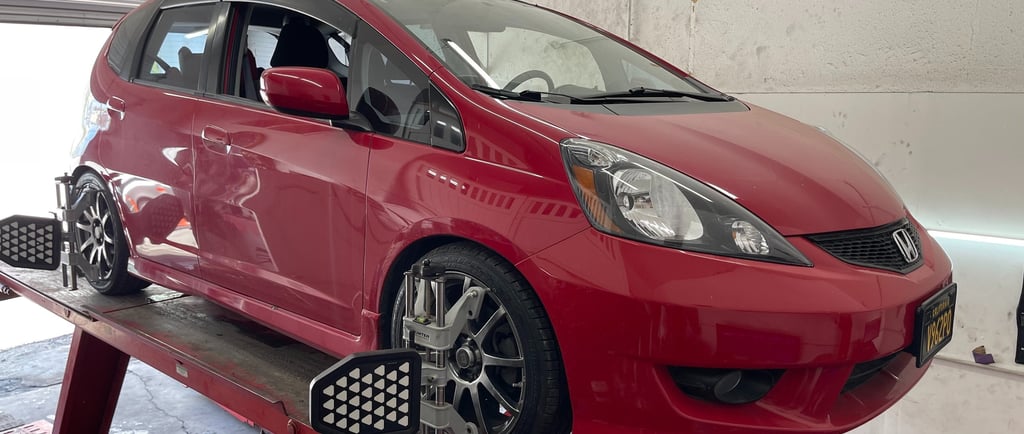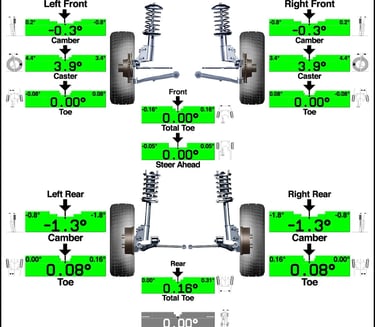The Science Behind Wheel Alignment: Understanding Camber, Caster, and Toe
Blog | Learn about the critical role of Camber, Caster, and Toe in wheel alignment. Understand how these angles impact your vehicle’s handling, tire wear, and overall driving safety. Regular alignment checks can enhance performance and prevent costly repairs post description.
WHEEL ALIGNMENT
George D.
8/17/20244 min read


Wheel alignment is one of those vehicle maintenance aspects that often goes unnoticed until issues arise. However, proper alignment ensures your car's safety, comfort, and longevity. In this article, we'll dive into three fundamental aspects of wheel alignment: Camber, Caster, and Toe. You'll learn how these factors influence your vehicle's handling and why keeping them properly adjusted is essential for a safe and smooth driving experience.
Definition: Camber refers to the angle at which your wheels tilt relative to the vertical axis of your vehicle when viewed from the front or rear. It's an essential parameter that affects how your vehicle interacts with the road surface.
Types of Camber:
- Positive Camber: The tops of the wheels tilt outward, away from the vehicle. This setup can improve stability in straight-line driving, particularly in larger vehicles or those carrying heavy loads.
- Negative Camber: The tops of the wheels tilt inward, toward the vehicle. This is often used in performance and sports cars to enhance cornering capabilities, as it allows for better contact between the tire and the road during turns.
- Zero Camber: The wheels stand perfectly vertical, creating even contact with the road surface, which is ideal for minimizing tire wear in normal driving conditions.
Impact on Handling: Camber affects how your vehicle handles and how evenly your tires wear. Negative camber improves grip and handling during turns, especially in high-performance vehicles, by maximizing the tire’s contact patch. However, excessive negative camber can cause the inner edges of your tires to wear out more quickly, leading to uneven wear and potentially reducing tire life.
Real-World Application: For most drivers, a slight negative camber is beneficial as it balances tire wear with improved handling. However, the ideal camber setting can vary depending on your vehicle type, driving style, and the specific demands of your driving environment. Regularly checking and adjusting the camber can help you maintain optimal tire health and vehicle performance.
What is Caster?
Definition: Caster refers to the angle of the steering pivot when viewed from the side of the vehicle. It's the angle created by the steering axis as it intersects with the ground, which plays a crucial role in the stability and handling of your vehicle.
Types of Caster:
- Positive Caster: The steering pivot tilts toward the rear of the vehicle. This is common in most vehicles as it enhances stability, especially at higher speeds, and helps the steering wheel return to the center after a turn.
- Negative Caster: The steering pivot tilts toward the front of the vehicle. Negative caster is uncommon in modern vehicles because it can cause instability and make steering feel light and unpredictable.
Impact on Handling: Caster primarily affects your vehicle's straight-line stability and steering feel. Positive caster makes the steering more responsive and helps the vehicle track straight, especially at higher speeds. It also makes the steering wheel return to its center position more easily after making a turn, contributing to a safer and more controlled driving experience.
Real-World Application: For everyday drivers, a positive caster angle is generally desirable as it improves stability and ensures smoother handling. However, the ideal caster angle can vary depending on the vehicle type and the driving conditions. Regular alignment checks ensure that the caster angle remains within the optimal range, enhancing both safety and driving comfort.
What is Toe?
Definition: Toe refers to the angle at which the wheels turn inward or outward when viewed from above. It’s the difference in distance between the front and rear of the tires on the same axle.
Types of Toe:
- Toe-In: The front of the wheels are closer together than the rear, which can improve stability at higher speeds.
- Toe-Out: The front of the wheels are farther apart than the rear, which can enhance cornering but may cause instability at high speeds.
Impact on Handling: Toe affects how your vehicle handles during turns and straight-line driving. Toe-in generally makes the car more stable on the road, while toe-out can make the vehicle more responsive during cornering but may lead to increased tire wear if not properly adjusted.
Real-World Application: Ensuring the correct toe setting is crucial for maintaining your vehicle’s handling characteristics. A misaligned toe can lead to uneven tire wear and poor handling, making it important to regularly check and adjust the toe angle as part of your vehicle's routine maintenance.
Understanding the roles of Camber, Caster, and Toe in wheel alignment is crucial for maintaining your vehicle's performance and safety. Each of these alignment angles plays a specific role in how your vehicle handles, how your tires wear, and how stable your car feels on the road. Regular alignment checks and adjustments can help prevent uneven tire wear, improve fuel efficiency, and ensure a smoother, safer driving experience. Don’t wait until you notice a problem—proactive maintenance is key to keeping your vehicle in top condition.
George D.
Unlocking the Secrets of Wheel Alignment: Camber, Caster, and Toe Explained


What is Camber?
Wheel alignment services by car type we provide:
Passenger vehicles - suitable for most sedans, coupes, compact cars, or all-wheel-drive vehicles as their hybrid versions
SUVs - compact, mid-size, full-size SUVs, crossovers, or off-road vehicles, as their hybrid version
Trucks and Minivans - trucks, heavy-duty trucks, pickups, commercial vehicles, or minivans
Lowered cars - Lowered cars
Classic cars - suitable for most Classic cars since 1950 your text here...
Electric cars - all types of electric cars including Tesla and Rivian
George's Alignment & Brake Service
Contacts:
Tel: +1 818 855 6545
Operation hours:
Mon-Fri: 10am - 5pm Sat: 9am - 5 pm
Service areas:
Calabasas Canoga Park Chatsworth Encino Granada Hills Hidden Hills Lake Balboa Northridge
Porter Ranch Reseda Sherwood Forest Tarzana Van Nuys West Hills Winnetka Woodland Hills
